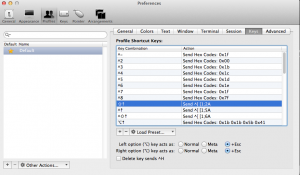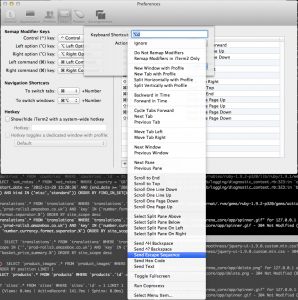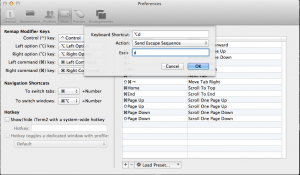-
ARM assembler in Raspberry Pi – Chapter 1
In my opinion, it is much more beneficial learning a high level language than a specific architecture assembler. But I fancied learning some ARM assembler just for fun since I know some 386 assembler. The idea is not to become a master but understand some of the details of what happens underneath.
-
Fast and easy way to block bots from your website using Apache
Some weeks ago the site I work on started having severe outages. It looked like the system was not able to fulfill the incoming requests fast enough, making the passenger queue to grow faster than new requests could be served.
Looking at the rails logs it looked like some Chinese bot was crawling the entire site, including a long list of dynamic pages that took a long time to generate and that are not usually visited. Those pages were not yet cached, so every request went through the rails pipeline. Once you start having the dreadful problem of your passenger queue to grow faster and faster you are usually doomed.
Since you can’t expect some of the malicious bots out there to respect the
robots.txtfile, I had to filter those requests at the Apache level so they did not even reach the application level. This past few months I’ve been learning a lot of systems administration, basically because it’s us, the developers, who also handle this part of the business.Since all those requests came from the same
user agent, I looked for a simple way to filter the requests based on this criteria. It can be easily done if you use themod_accessApache module. All you need to do is make use of theAllowandDenydirectives. Here’s a simple example to filter theezoomsbot:<Directory "/home/rails/sites/prod/your_site/current/public"> SetEnvIf User-Agent "ezooms" BlockUA Order allow,deny Deny from env=BlockUA Allow from all </Directory>What this piece of code does is very self explanatory. The first line tells Apache to set up an environment variable called
BlockUAif theuser agentof the request matches the “ezooms” string. Then you tell Apache the order it has to evaluate the access control to the directory: it first has to evaluate theAllowdirective, and then theDenyone. After that you set up both directives.Allow from allbasically allows everything in.Deny from env=BlockUAdenies all requests in which the environment variableBlockUAhas been set. Since that variable is set up when theuser agentmatches our desired string, the config will basically deny access to the application to all requests with the “ezooms” user agent.This way you can easily protect yourself from basic bot attacks.
-
Node.js packages in Mountain Lion
tl;dr: make sure you add
/usr/local/share/npm/binto yourPATHwhen installing node.js to be able to access the package binaries.Developing in Ruby on Rails on a Mountain Lion environment can be a pain. Although it’s a UNIX-like environment, most of the tools created for web development have been made with Linux in mind, and making the switch from a Linux box to Mac OS X is far from harmless.
Anyway, the other day I needed to tweak Bootstrap to make the default grid wider, and instead of using the Bootstrap web site customiser, I decided to download the source code from GitHub and build it myself.
In order to do this, you need node.js and some of the packages that come with it. I’ve never developed or even played with node.js before, so I needed to install it on the computer. And that was fairly easy thanks to homebrew by simply issuing the command
brew install node.After node has been installed you have access to
npm, the node package manager. Following the Bootstrap instructions, I installed the necessary packages:npm install recess connect uglify-js jshint -gAfter that I thought I was ready to build Bootstrap, but the make command complained about not being able to find some of the node.js binaries I’ve just installed a minute ago.
The solution to the problem, though, was rather simple. It turns out the default formula for nodejs on homebrew doesn’t tell you the folder in which the node.js binaries will be installed in. Without adding this folder to the path, obviously the system can’t find the files it’s supposed to execute.
Simply add the folder
/usr/local/share/npm/binto yourPATHenvironment variable and you’ll be good to go. -
Mac OS X, iTerm and the meta key
If you use your Mac OS X as a development machine and are a regular user of the shell, chances are you are going to be using the movement commands a lot. Chances are, too, that you are using iTerm instead of the system provided Terminal app.
Using the arrow keys is usually enough, but more often than not you need to move between words. This movements, unless you redefine it in your global or local bashrc profile (or any similar shell you maybe using), are done with the keys
bandf. PressingC-borC-fmoves the cursor one character back or forward. Doing if withM-borM-fdoes the same but with a word (if you are an Emacs user you will be familiar with those key shortcuts).The
Cstands forcontrol key, while theMstands formeta key. In most keyboards (or keymaps to be precise), the control key is mapped to thectrlkey and the meta key is mapped to thealtkey. In Mac OS X, the meta key is mapped to thealtkey, but as you may very well know, this alt key is known as theoptionkey, and has its peculiarities.Now, if you open a shell in iTerm and press
C-borC-f, the output will be as expected, but not if you pressM-borM-f. Instead of moving forward or backward a word, you will see that some weird character is written on the command line.Fortunately this is really easy to fix in iTerm. You just need to go to the Profiles menu, edit your profile (which is most likely to be the default one), and then go to the keys tab. Now, on the bottom of the keymap lists, you will see that you can configure the behaviour of the option key. Set it up to the last option (+Esc) as shown in the screenshot, and then the alt key in iTerm will be sending the shell the adequate escape sequence so all meta mappings work as expected.

iTerm profile editor EDIT (30/11/2012): looks like this breaks some of the characters that are used by typing the meta key, i.e. the # character (meta + 3). Another way to achieve what we want is to manually map all the meta key shortcuts. This can be done in the same window as before. Select Normal instead of +Esc and, for each key shortcut you want to map, click on the + button. On the opening dialog, type the combination you want to map, for example alt + d, and select Send escape sequence from the drop down Then on the last textbox insert the escape sequence character you want to send (typically the same pressed along the meta key).

Select Send Escape Sequence 
Type the character to send -
Why I will never buy an Apple product again
Well, here it is. This is not a tech post. Not a programming post either. This is just a rant I really needed to put online for some people to know. Also, I know this will never appear on Hacker News but I always wanted to write one of those “why I <type here a randomly shit nobody really cares about>” posts :)
tl;dr: Apple are a bunch of jokers.
Here’s the story. Last week my MacBook decided to refuse booting. It’s a late 2008 model (the first Unibody), and I was hoping it wasn’t because of a hardware issue. Actually, the machine booted, but it would refuse to show the login screen after the initial load and the second appearance of the Apple logo. For the record, I had Mountain Lion installed on it and have had no problems so far. After trying some things like repairing disk permissions, clearing the NVRAM, do a safe boot and some other black magic suggested in the Apple support pages and a good friend who happens to know a lot about the Mac world, I came to the conclusion that the problem was really not repairable and decided to go for a clean Mountain Lion install.
After booting the box into a Ubuntu Live CD and backing up some non essential files that I’d rather not lose either, I reinstalled Mountain Lion. Everything was fine. I had now a clean Mountain Lion installation on a laptop without any noticeable hardware issues. I had just only lost some hours of my time. No big deal.
But then I went to the Mac App Store to redownload and reinstall iPhoto. To my surprise, the App did not appear as purchased. The system was asking me to pay the £13 or so it cost. The thing is, I had already purchased iPhoto 3 months ago. So I decided to email Apple support and ask for help.
This was the answer: “You purchased iPhoto when your Apple ID country was Spain, and then you changed your Apple ID country to United Kingdom, so you lost all purchases made while your ID was linked to Spain”. And this is in fact true: I moved from Barcelona to London 3 months ago and decided to change my Apple ID country to the UK. What I did certainly not know is that stupid policy of you losing all purchases when changing countries.
So I replied Customer Service to actually get a clarification on that, and the answer was crystal clear: “yes, all purchases in the App Store are linked to the country of your Apple ID, so if you change it, you lose the purchases”.
It seems this is no recent news, as a search on the internet showed different people having to deal with the same issue. But this did not make it less stupid. What kind on nonsense and stupid policy is that?
I could understand a similar policy with movies or music, as all those monster major distribution companies issue rights to watch or listen to certain material on a country basis. This is obviously a matter for another post and another site. But for software? And even worse, software being developed and sold by Apple themselves?
When did we all go so fucking crazy about everything?
So I asked Apple again: “are you telling me that I bought a software from you 3 months ago to run on this machine, and now, 3 months later, after having to do a system clean installation, on the same fucking machine, I have to pay AGAIN for the same fucking software?” The answer was clear again: “yes, I’m aware this is not the answer you were expecting but it’s how it works”. And then this hilarious predefined quote at the bottom of the email telling me “how happy we are to have you as a member of the Apple family”. Ha!
Searching on google again, I found out some people managed to get a refund because of that, so I thought I had nothing to lose to try. I emailed again (and did the same through the feedback links on Apple’s web site asking for a refund and telling them as nicely as I was able to do given the fucking circumstances that I felt like I was treated like garbage.
Let’s be honest. I am not one of those really old Apple customers. This MacBook was my second one and besides that I’ve only owned an iPod mini, two iPhones and an iPad (and I have to say the overall experience with both those products and the company was clearly positive). So no, I am not one of those poor sad bastards that go queue during the night to get a fucking gadget the day it gets released (although I have to admit I’ve done that with the World of Warcraft: The Burning Crusade release). But this really has nothing to do with it. They just crossed the line. Again. And yes, I know there is some shitty legal things involved in all this regarding VAT and some other things, but this is NOTHING Apple can not get over to make an App purchase valid if you fucking move countries.
In the end Apple resolved my issue by giving me some redeem codes, not only for iPhoto but also for iMovie and GarageBand (apps that I do not use and I’m very unlikely to do so in the future), but not because of what happened, according to the Customer Service email, but because “we have checked that the MacBook you bought came with iLife, so we are generous enough to let you fucking download again a software you already paid for 3 months ago”.
Well, you know what? You’ve lost a customer for a fucking £13 App.
Good job, Apple.